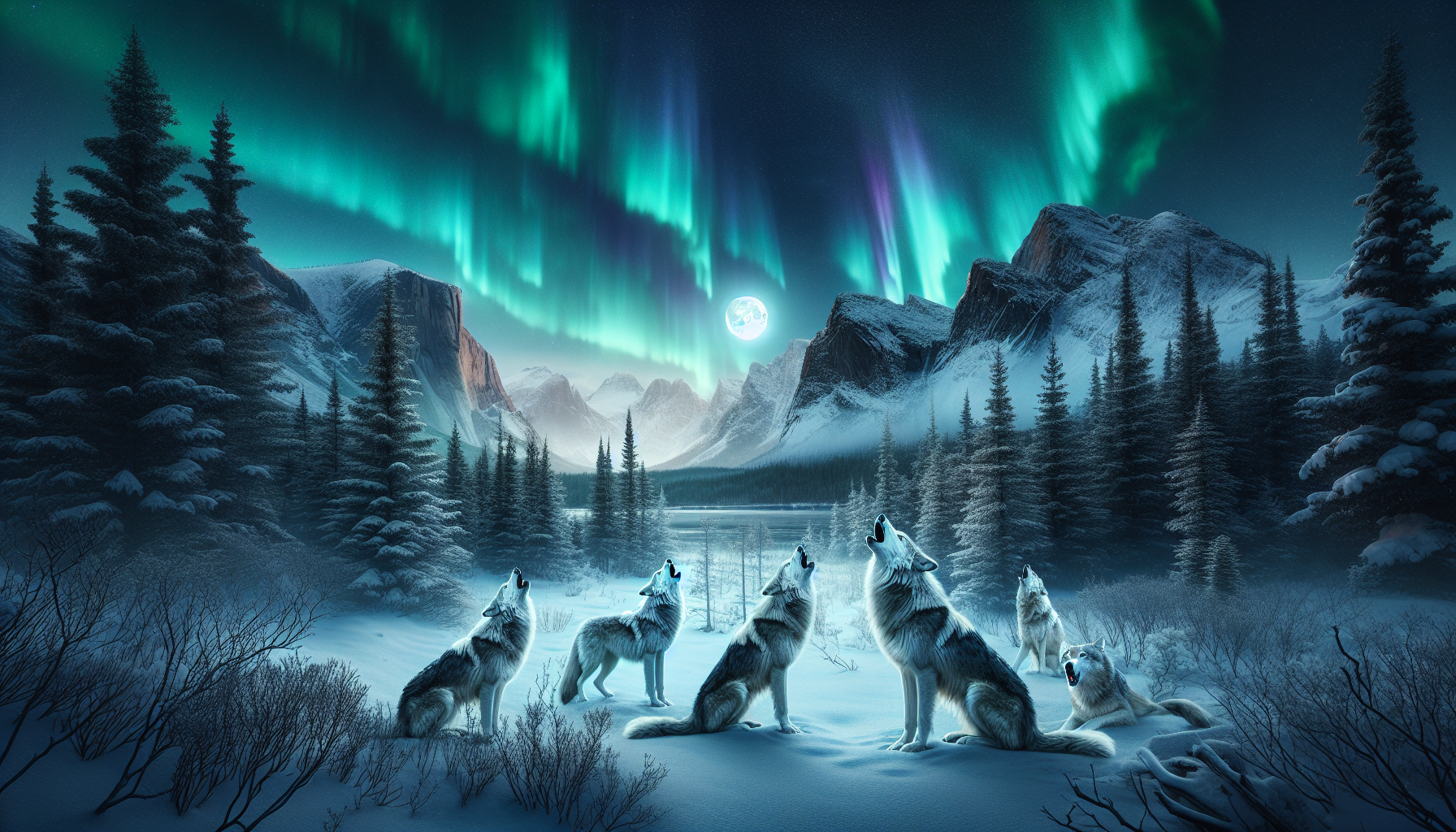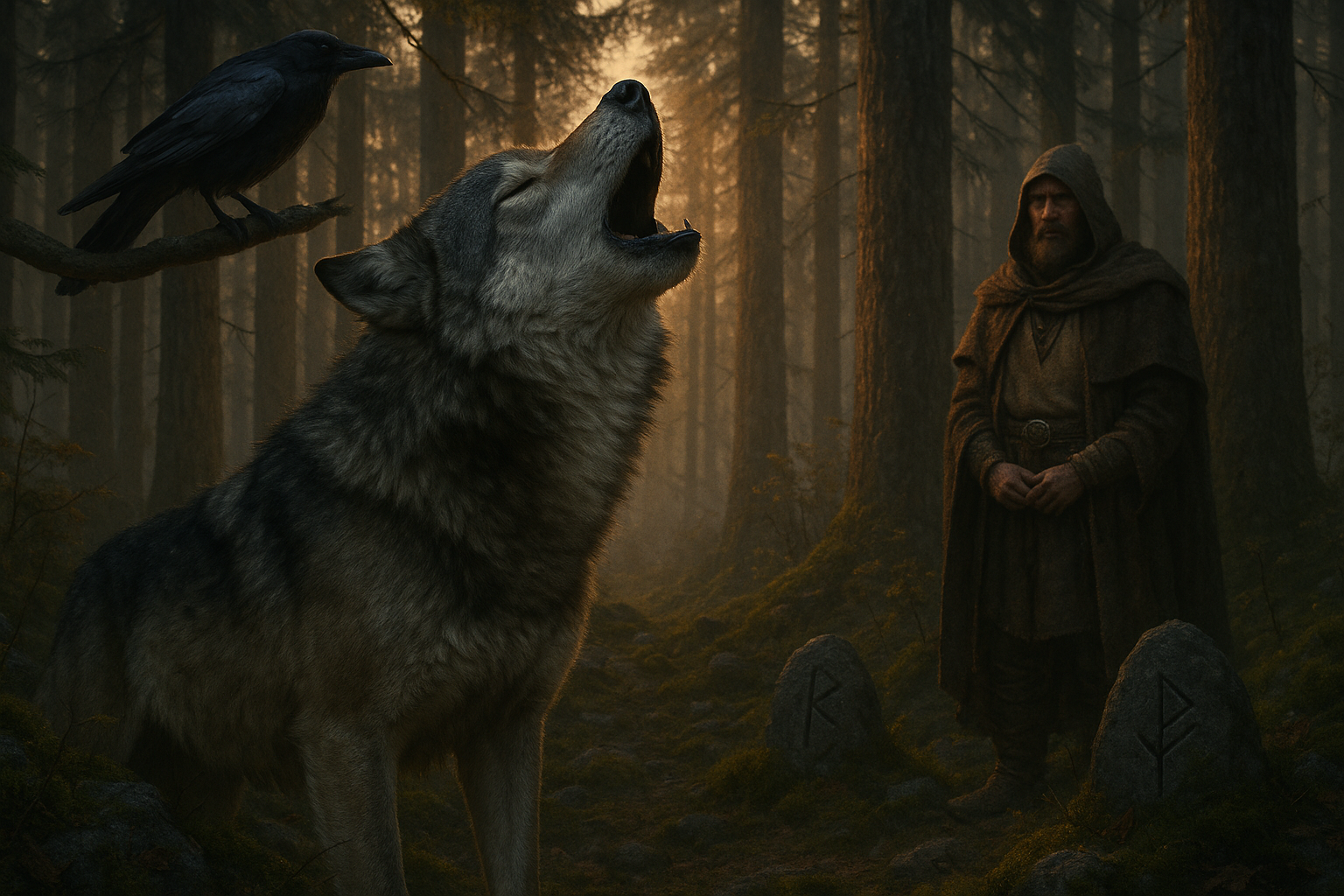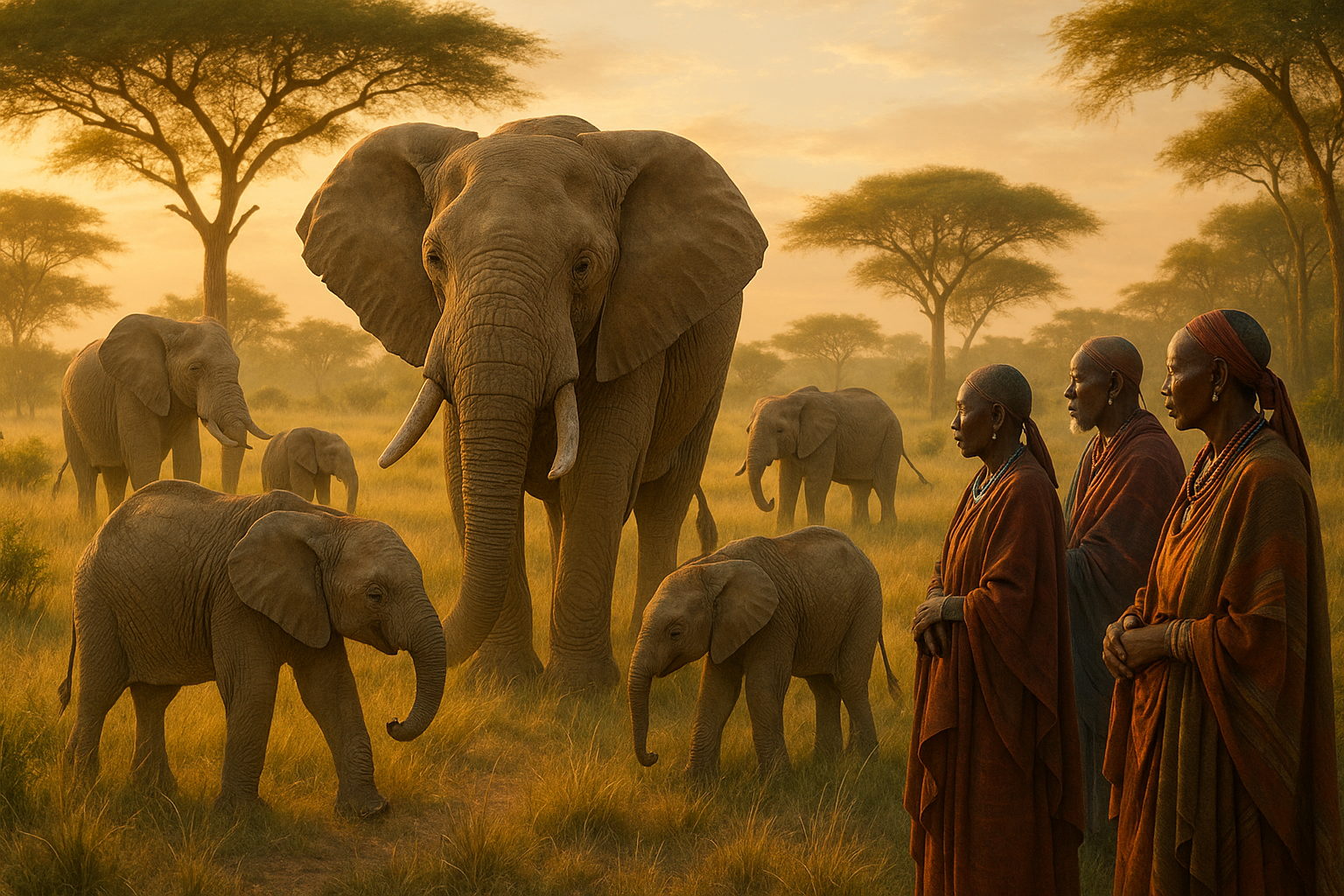In the shadowy realm of ancient myths and legends, where gods wield thunderbolts and giants roam the frozen landscapes, there exists a fascinating tapestry woven with tales of mythical beasts. Among these enigmatic creatures, none capture the imagination quite like the howling wolves of Norse lore. 🐺 From the chilling winds of the Scandinavian wilderness to the sacred halls of Asgard, these majestic creatures prowl through sagas and songs, embodying both fear and reverence. As we embark on this journey through time, prepare to be mesmerized by stories that transcend mere fiction, delving into the very fabric of human belief and the cosmos as understood by the Norse people.
At the heart of these tales lie two of the most formidable wolves to ever grace the pages of mythology: Sköll and Hati. These fearsome siblings are destined to chase the sun and moon across the heavens, a perpetual pursuit that echoes the cyclical nature of time and existence. Their relentless chase is not just a celestial event but a metaphor for the eternal struggle between chaos and order, light and darkness. We’ll explore the profound symbolism embedded in their stories and how these myths have shaped cultural perceptions, influencing everything from Viking rituals to modern interpretations of Norse mythology. 🌕🌒
But the power of the howling wolves extends beyond Sköll and Hati. We will also delve into the tale of Fenrir, the monstrous wolf bound by the gods themselves, whose eventual release is foretold to bring about Ragnarok, the end of the world. This narrative of doom and rebirth serves as a potent reminder of the fragile balance within the cosmos. Through the lens of Fenrir’s story, we’ll unravel themes of fate, power, and the inescapable nature of prophecy. Join us as we unleash the power of these mythical beasts, uncovering their significance within Norse culture, their impact on later storytelling, and the lessons they offer to our modern world. Prepare to enter a world where mythology breathes life into the primordial wilderness, guiding us through an exploration of epic proportions. 🌌
The Howling Wolves of Norse Mythology: A Glimpse into the Beastly Realm
Norse mythology is replete with vivid imagery and powerful creatures, and among these entities, the wolves stand out as formidable figures. The tales of these wolves are intricately woven into the fabric of Norse lore, symbolizing chaos, destruction, and transformation. In this article, we delve deep into the narratives surrounding the mythical wolves, exploring their origins, roles, and significance in Norse mythology. Join us as we journey through ancient tales to uncover the mysteries of these legendary beasts.
Origins of the Mythical Wolves
The mythical wolves of Norse mythology, most notably Fenrir, Sköll, and Hati, have roots that trace back to the earliest sagas and oral traditions of the Norse people. These creatures are often portrayed as the progeny of Loki, the trickster god, and the giantess Angrboða. Fenrir, the most notorious among them, is destined to play a crucial role in the apocalyptic events of Ragnarök.
In the Norse cosmos, wolves symbolize both the uncontrollable forces of nature and the cycle of life and death. The tales describe these creatures as powerful beings that challenge the gods and bring about monumental change. For instance, Fenrir is known for his role in the death of Odin during Ragnarök, a testament to his immense power and significance. The story of Fenrir encapsulates themes of betrayal, fear, and the inevitable clash between the divine and the beastly.
Another significant aspect of the wolves in Norse mythology is their association with the celestial bodies. Sköll and Hati, for instance, are said to chase the sun and moon across the sky, creating the natural phenomenon of day and night. This chase is a symbolic representation of the relentless passage of time and the ever-present threat of chaos disrupting the cosmic order. This cyclical pursuit mirrors the perpetual struggle between order and disorder, a recurring theme in many mythological traditions.
Fenrir: The Monstrous Wolf
Fenrir, often depicted as an enormous wolf with unmatched strength, is one of the most feared creatures in Norse mythology. His story is one of prophecy, betrayal, and ultimate destruction. According to the myths, the gods, aware of the threat posed by Fenrir, decided to bind him to prevent the prophesied destruction he would bring during Ragnarök.
To restrain Fenrir, the gods used a magical chain known as Gleipnir, crafted by dwarves from six impossible ingredients: the sound of a cat’s footfall, a woman’s beard, mountain roots, bear sinews, fish breath, and bird spittle. This chain was strong yet deceptively thin, and it successfully held Fenrir until the time of Ragnarök. This tale underscores themes of fate and inevitability, as despite their efforts, the gods could not alter the destined events of Ragnarök.
Fenrir’s role during Ragnarök is pivotal. He is destined to break free from his chains, wreak havoc, and ultimately devour Odin, the Allfather. This act signifies the collapse of the existing order and the onset of a new era. The imagery of Fenrir devouring Odin is a powerful metaphor for the cyclical nature of destruction and rebirth in Norse cosmology.
Symbolism of Fenrir in Modern Contexts
Fenrir’s story has transcended its mythological origins, finding resonance in contemporary culture and literature. The wolf’s symbolism as a force of chaos and change continues to captivate audiences worldwide. Fenrir represents the untamable aspects of nature and the human psyche, embodying the primal instincts that lie beneath the surface of civilization.
In modern interpretations, Fenrir often appears in literature, films, and games as a symbol of rebellion and transformation. His tale serves as a reminder of the delicate balance between control and chaos, order and disorder. Fenrir’s enduring legacy speaks to the universal themes of struggle, power, and the inevitability of change.
The Celestial Chase: Sköll and Hati
Sköll and Hati, the celestial wolves, play a crucial role in the Norse understanding of time and natural cycles. According to the myths, these wolves are destined to chase the sun and moon across the sky, an eternal pursuit that maintains the rhythm of day and night. Sköll is said to pursue the sun, while Hati chases the moon, and their chase symbolizes the perpetual motion of the cosmos.
The presence of Sköll and Hati in Norse mythology highlights the interconnectedness of all things and the delicate balance that sustains the universe. Their pursuit represents the inevitability of time and the ever-present threat of chaos breaking through the established order. This narrative serves as a reminder of the transient nature of existence and the importance of maintaining harmony within the cosmic cycle.
In many ways, the tale of Sköll and Hati echoes the cyclical themes present in other mythological traditions, where the relentless passage of time and the struggle between light and darkness are central motifs. The wolves’ chase is a metaphor for the eternal battle between opposing forces, a theme that resonates across cultures and continues to inspire interpretations in various artistic forms.
Modern Interpretations and Cultural Impact
The story of Sköll and Hati has inspired countless artistic representations, from visual arts to literature and music. Their pursuit of the sun and moon serves as a powerful allegory for the human experience, symbolizing the relentless pursuit of goals and the cyclical nature of challenges and triumphs. In modern culture, the imagery of these celestial wolves continues to captivate and inspire.
Artists and writers often draw upon the symbolism of Sköll and Hati to explore themes of pursuit, ambition, and the passage of time. The wolves’ chase serves as a poignant reminder of the transient nature of existence and the perpetual cycle of creation and destruction. As such, their story remains relevant, offering insights into the human condition and the timeless struggle for balance and harmony.
The Role of Wolves in Norse Cosmology
Wolves occupy a significant place in Norse cosmology, serving as both adversaries and allies to the gods. Their presence in the myths underscores the duality of nature, embodying both the destructive and protective aspects of the natural world. In addition to Fenrir, Sköll, and Hati, other wolves such as Geri and Freki, Odin’s companions, highlight the complex relationship between wolves and the divine.
Geri and Freki, often depicted alongside Odin, represent the protective and loyal attributes of wolves. These companions serve as symbols of Odin’s connection to the wild and his ability to harness the power of nature. Their presence in the myths emphasizes the duality of wolves, showcasing their role as both destroyers and guardians.
The recurring motif of wolves in Norse mythology reflects the deep-rooted connection between the Norse people and the natural world. Wolves, with their fierce independence and strength, embody the spirit of the wild, and their stories offer insights into the balance of power and the eternal dance between chaos and order.
Table: Comparison of Mythical Wolves
| Wolf | Role | Symbolism |
|---|---|---|
| Fenrir | Destined to kill Odin during Ragnarök | Chaos, destruction, transformation |
| Sköll | Chases the sun | Time, cosmic balance |
| Hati | Chases the moon | Time, cosmic balance |
| Geri and Freki | Companions of Odin | Loyalty, protection, connection to nature |
Conclusion: The Enduring Legacy of Norse Wolves
The wolves of Norse mythology continue to captivate the imagination of people around the world. Their stories, rich with symbolism and meaning, offer timeless insights into the human experience and the natural world. As we explore the tales of Fenrir, Sköll, Hati, and other mythical wolves, we gain a deeper understanding of the forces that shape our lives and the eternal struggle for balance and harmony.
In modern culture, the imagery of these wolves endures, inspiring artists, writers, and storytellers to explore themes of chaos, transformation, and the relentless pursuit of destiny. The tales of the Norse wolves remind us of the primal instincts that lie within us and the enduring power of mythology to illuminate the mysteries of existence.
For a visual exploration of the themes discussed, we recommend watching this video on Norse Mythology: The Wolves and Their Symbolism by [Channel Name]. Dive deeper into the mythos and let the stories of these legendary wolves ignite your imagination. 🌕🐺

Conclusion
Unleashing the power of the howling wolves in Norse mythology invites us to journey through a fascinating landscape of myth and legend, where these majestic creatures hold profound significance. As we’ve explored, wolves in Norse lore are not merely animals; they are powerful symbols interwoven with the fate of gods and the cosmos itself. In this concluding section, we will recapitulate the core themes discussed, highlight the enduring impact of these mythical beasts, and encourage further exploration and reflection on their significance.
Throughout this exploration, we have delved into the multi-faceted roles wolves play in Norse mythology. Central to our discussion was the legendary duo, Fenrir and Sköll and Hati, whose narratives encapsulate the intrinsic connection between wolves and the cosmic cycles. Fenrir, the monstrous wolf destined to break free during Ragnarök, symbolizes the inevitable chaos and renewal within the Norse cosmos. Meanwhile, Sköll and Hati, the celestial wolves who chase the sun and moon, embody the perpetual cycles of day and night, order and chaos.
These wolves are not mere figments of imagination but rather represent deeper philosophical and existential themes. They embody the tension between order and chaos, fate and free will, which are central to the Norse understanding of the universe. As we have discussed, the presence of wolves in these stories serves as a reminder of the natural forces that shape and redefine existence. Their narratives compel us to ponder our own place within these cycles and our responses to the challenges they present.
Moreover, we’ve examined how these mythical wolves have transcended their origins to influence contemporary culture and storytelling. From literature to film, the archetype of the wolf continues to resonate, evoking a blend of fear, respect, and admiration. This enduring presence underscores the universal appeal of these creatures and their symbolic richness. They challenge us to confront our primal instincts, our courage in the face of the unknown, and our capacity for transformation.
In reflecting on the broader implications of these myths, it becomes evident that the wolves of Norse lore offer valuable lessons that extend beyond their mythical narratives. They encourage us to embrace change, confront our fears, and acknowledge the cyclical nature of life. As we navigate our own journeys, we are reminded of the importance of balance between light and dark, order and chaos—a dance that is beautifully encapsulated in the chase of Sköll and Hati.
As we conclude this exploration, the power of these howling wolves urges us to consider our own stories and the roles we play in the grand tapestry of life. Just as these mythical beasts have left an indelible mark on Norse mythology and beyond, we too have the capacity to shape our narratives and influence the world around us. Let this exploration inspire you to delve deeper into the rich tapestry of mythology and to draw lessons that resonate with your personal journey.
We encourage you to share your thoughts and reflections on the enduring significance of these mythical wolves. Whether through a comment on this article or a conversation with friends, your engagement enriches the dialogue and keeps these ancient stories alive. Additionally, consider exploring further readings and resources to deepen your understanding of Norse mythology and its contemporary relevance. Below are some active links that offer valuable insights:
– [Norse Mythology for Smart People](https://norse-mythology.org/)
– [The Viking Spirit: An Introduction to Norse Mythology and Religion](https://www.amazon.com/Viking-Spirit-Introduction-Mythology-Religion/dp/1533393036)
– [The Old Norse Language and How to Learn It](https://www.amazon.com/Old-Norse-Language-How-Learn/dp/1466284069)
In closing, let the howling of the wolves echo in your consciousness as a reminder of the powerful forces that shape our lives. May you find inspiration in their stories, courage in their symbolism, and wisdom in their lessons. 🐺
Toni Santos is a sound storyteller and folklore researcher whose creative path bridges the mystical and the biological through the lens of bioacoustic folklore. With an ear attuned to the voices of nature, Toni explores how ancient cultures interpreted birdsong, forest echoes, and animal calls—not as noise, but as messages, omens, and myths encoded in sound.
Rooted in a passion for both natural science and ancestral lore, his work uncovers the forgotten connections between ecosystems and oral traditions. From the whispered warnings in owl cries to the songs of frogs heralding rain, Toni’s narratives evoke a time when humans listened to nature with reverence and meaning.
Drawing on a background in ecological arts and auditory storytelling, Toni merges field recordings with mythic imagery, turning natural sounds into cultural artifacts of wonder. His stories do more than entertain—they restore a way of hearing the world that blends intuition, memory, and deep listening.
As the creative force behind Vizovex, Toni offers sonic tales, symbolic soundscapes, and research-based reflections that help others rediscover the sacred language of the wild.
His work is a tribute to:
The mythological significance of animal and elemental sounds
Ancient practices of listening for meaning in nature
The spiritual dialogue between humans and soundscapes
Whether you’re a folklorist, an acoustic ecologist, or a curious listener, Toni invites you into a world where the forest speaks, and every chirp, croak, and howl carries a story—one echo, one legend, one call at a time.



